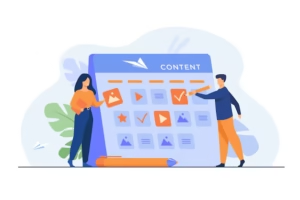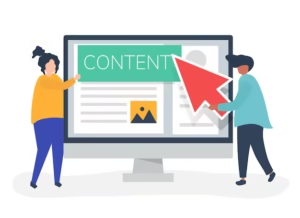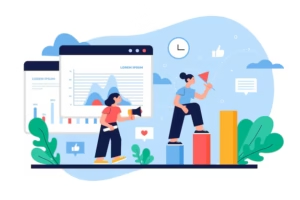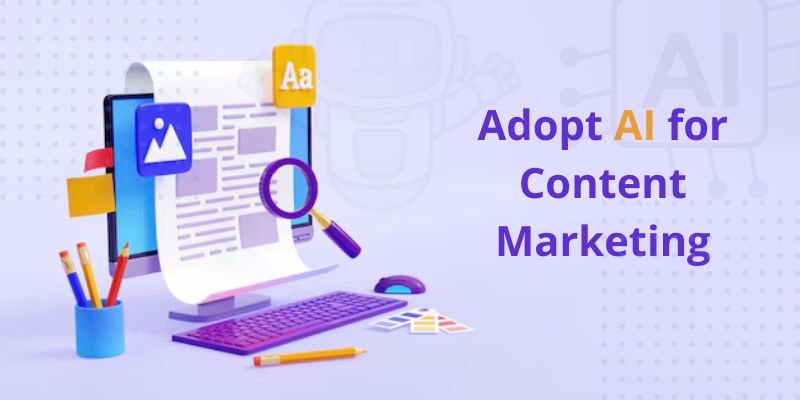Introduction
Content is still king in the dynamic realm of digital marketing. But producing regular, high-quality content may be difficult, particularly when you’re balancing several platforms, campaigns, and target groups. *Artificial Intelligence (AI)* is a game-changer in this situation. AI has evolved from a sci-fi idea to a useful instrument that is revolutionizing the way companies handle content marketing. AI may help you save time and improve the outcomes of your content marketing efforts by streamlining tasks like idea generation, copywriting, search engine optimization, and performance analysis. In order to keep ahead of the competition, we’ll go over how to implement AI for content marketing step-by-step in this blog article.
Why Use AI in Content Marketing?
AI adoption in content marketing is a calculated decision that has real advantages for companies of all sizes, not just a passing fad. AI’s capacity to *save time is among its most important benefits. Researching keywords, coming up with ideas for topics, and monitoring performance are just a few of the many repetitive chores involved in content development. These chores can be automated by AI, giving you more time to concentrate on strategy and creativity. AI may **improve the quality of your content* as well. In addition to being well-written, tools like grammar checkers and SEO optimizers make sure that your content is optimized for search engines and user interaction.
AI’s capacity to *personalize material is yet another strong argument for its adoption. Customers want information in today’s digital environment that immediately addresses their wants and requirements. By analyzing user data, AI can provide highly customized content experiences that increase engagement and conversions. Lastly, **data-driven decision-making* is made possible by AI. AI may assist you in improving your content strategy and achieving better outcomes by evaluating performance data and spotting trends. To put it briefly, AI helps you remain ahead of the competition in the cutthroat field of content marketing by enabling you to work smarter, not harder.
How to Adopt AI for Content Marketing: A Step-by-Step Guide
Step 1: Use AI for Content Ideation
Developing concepts that appeal to your audience is the first stage in any content marketing approach. However, coming up with original and pertinent ideas might be difficult, particularly if you’re aiming for a niche market. AI has the potential to revolutionize this situation. Large volumes of data may be analyzed by AI-powered systems to find popular keywords, trending themes, and commonly asked questions in your sector. To create a list of content ideas depending on your target demographic or specialty, for instance, utilize *ChatGPT*. Alternatively, you may find out what’s popular and what queries your audience is asking online with the use of technologies like *BuzzSumo* and *AnswerThePublic*.
Combining AI-generated concepts with your own knowledge and originality is crucial. Although AI can offer a plethora of recommendations, it is your responsibility to hone these concepts and match them with the objectives and core values of your company. You can make sure that your material is timely, relevant, and interesting by using AI to generate ideas.
Step 2: Automate Content Creation
The next step after compiling a list of ideas is to produce excellent content. Writing email newsletters, blog articles, and social media captions might take a lot of effort, but AI can help you do it more quickly. Advanced natural language processing (NLP) algorithms are used by programs like *Jasper.ai* and *Writesonic* to produce material in a matter of minutes. These programs can generate drafts of blog posts, ad content, or product descriptions that you may modify and customize.
*Grammarly* is another useful application that employs AI to check your work for spelling, grammar, and style mistakes. Additionally, it offers recommendations for improving tone and clarity, guaranteeing that your writing is polished and businesslike. Even while AI-generated content might save you time, it’s still crucial to check and edit it to make sure it fits your brand’s messaging and voice. Consider AI as a cooperative partner that enables you to produce material more quickly and effectively, but always add your own touch to make it genuinely yours.
Step 3: Optimize Content for SEO
Making excellent content is just half the fight; the other half is making sure your target audience sees it. *Search Engine Optimization (SEO)* is relevant in this situation. Your content will rank better and receive more organic traffic if you use AI to optimize it for search engines. Top-ranking sites are analyzed by tools like *Surfer SEO* and *Frase*, which then offer suggestions for improving your content. They can recommend the best word count, keyword density, and header format for your blog entries, for instance.
Furthermore, real-time recommendations for enhancing your on-page SEO, such as adding internal links, alt text, and meta descriptions, are provided by tools like *Yoast SEO*. You can produce content that not only connects with your audience but also ranks highly in search engine results by utilizing AI for SEO. Keep in mind that SEO is a continuous process, so to keep your material relevant and ranking well, check and update it frequently.
Step 4: Personalize Content for Your Audience
Customers need individualized experiences in the current digital era. One-size-fits-all, generic material is no longer sufficient. Delivering tailored content that precisely addresses the wants and requirements of your audience is made possible by AI. For instance, *HubSpot* segments your audience using AI and sends tailored email messages according to user choices and activity. Similar to this, programs like *Dynamic Yield* and *OneSpot* may leverage user data to provide suggestions and customized website content.
Using information from your CRM, analytics software, and social media networks is essential for successful customization. AI may assist you in producing hyper-targeted content that connects with your audience and encourages interaction by evaluating this data. AI-powered customization may greatly improve your content marketing efforts, whether it’s through a customized landing page, a personalized email, or a product suggestion.
Step 5: Automate Content Distribution
Just producing excellent content isn’t enough; you also need to make sure that your target audience sees it. By automating content distribution, artificial intelligence (AI) can help you make sure that your material is seen by the right people at the right time on the appropriate platforms. Schedule social media postings and track their effectiveness with tools like *Buffer* and *Hootsuite*. Similar to this, *CoSchedule* can assist you in organizing and automating every aspect of your content schedule, including email campaigns and blog entries.
AI may also assist you in determining the optimal posting times by analyzing the behavior of your audience. For instance, AI may arrange your posts to optimize interaction if your audience is most engaged on social media in the nights. You can make sure that your audience sees your material at the optimal moment for interaction by automating the distribution of your content.
Step 6: Analyze and Optimize Performance
Analyzing results and refining your approach is the last phase in implementing AI for content marketing. You can track important metrics like traffic, engagement, and conversions with AI’s assistance and pinpoint areas that need work. AI-powered insights are used by tools like *Google Analytics* to provide you a better picture of how well your content is performing. AI may be used, for instance, to determine which social media campaigns are producing the most interaction or which blog entries are bringing in the most traffic.
You may also use tools like *Crayon* to monitor the content strategy of your rivals and spot any weaknesses in your own. You may make data-driven judgments and continually improve your content strategy to get better outcomes by using AI for performance analysis. Keep in mind that content marketing is a continuous process, so evaluate your statistics frequently and modify your approach in light of what is (and is not) working.
Benefits of Adopting AI for Content Marketing
Save Time and Resources
The potential of AI to automate tedious processes like content scheduling, keyword research, and performance monitoring is among its most important advantages. You may save time and concentrate on more strategic elements of content marketing, including creativity and innovation, by automating these processes.
Improve Content Quality
AI technologies may assist you in producing well-written, SEO-optimized, and brand-voice-consistent, high-quality content. AI can improve the quality of your content and make sure that it appeals to your audience, whether it is used for blog post generation, grammatical correction, or search engine optimization.
Boost Engagement and Conversions
Content that is data-driven and personalized has a higher chance of engaging your audience and increasing conversions. You can improve outcomes and forge closer bonds with your audience by using AI to provide tailored content experiences.
Stay Ahead of the Competition
It’s critical to keep ahead of the competition in the fast-paced digital world of today. You may gain a major competitive advantage by using AI to produce and distribute content more quickly and efficiently than your rivals.
5 Most-Searched FAQs About AI in Content Marketing
1. Can AI replace human content creators?
No, AI cannot take the place of human content producers. AI is capable of creating content and automating processes, but it lacks human creativity, empathy, and strategic thinking. Consider AI as a supplement to human creativity and productivity, not a replacement for it.
2. Is AI-generated content SEO-friendly?
Indeed, a lot of AI technologies are made to produce material that is optimized for search engines. To make sure the material fits with your brand voice and SEO strategy, it’s crucial to examine and edit it.
3. How much does it cost to adopt AI for content marketing?
Depending on the technologies you employ, implementing AI for content marketing might cost different amounts. While some applications, like Grammarly and ChatGPT, have free plans, others, like Surfer SEO and Jasper.ai, need a membership. Selecting tools that fit your needs and budget is crucial.
4. What are the risks of using AI in content marketing?
Over-reliance on AI, loss of brand voice, and possible mistakes in AI-generated content are the key concerns associated with employing AI in content marketing. Always check and revise AI-generated material before posting to reduce these risks and make sure it reflects the objectives and core values of your company.
5. How do I get started with AI for content marketing?
Choose AI technologies that meet your goals after determining your major obstacles (such as ideation, creation, or distribution) before implementing AI for content marketing. Try out free trials first, then progressively incorporate AI into your operations. Keep in mind that AI is a tool to supplement, not to replace, your efforts.
Conclusion
In the current digital environment, using AI for content marketing is becoming essential rather than optional. AI can help you save time, improve outcomes, and streamline your content marketing activities from conception and development to distribution and analysis. You can remain ahead of the competition and incorporate AI into your content marketing plan with ease by following the instructions in this post. So, are you prepared to welcome content marketing’s future? The time to begin is now, and the opportunities are limitless.
For more Detail

